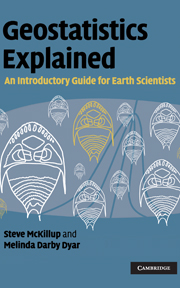Book contents
- Frontmatter
- Contents
- Preface
- 1 Introduction
- 2 “Doing science”: hypotheses, experiments and disproof
- 3 Collecting and displaying data
- 4 Introductory concepts of experimental design
- 5 Doing science responsibly and ethically
- 6 Probability helps you make a decision about your results
- 7 Working from samples: data, populations and statistics
- 8 Normal distributions: tests for comparing the means of one and two samples
- 9 Type 1 and Type 2 error, power and sample size
- 10 Single-factor analysis of variance
- 11 Multiple comparisons after ANOVA
- 12 Two-factor analysis of variance
- 13 Important assumptions of analysis of variance, transformations and a test for equality of variances
- 14 Two-factor analysis of variance without replication, and nested analysis of variance
- 15 Relationships between variables: linear correlation and linear regression
- 16 Linear regression
- 17 Non-parametric statistics
- 18 Non-parametric tests for nominal scale data
- 19 Non-parametric tests for ratio, interval or ordinal scale data
- 20 Introductory concepts of multivariate analysis
- 21 Introductory concepts of sequence analysis
- 22 Introductory concepts of spatial analysis
- 23 Choosing a test
- Appendices
- References
- Index
14 - Two-factor analysis of variance without replication, and nested analysis of variance
Published online by Cambridge University Press: 05 June 2012
- Frontmatter
- Contents
- Preface
- 1 Introduction
- 2 “Doing science”: hypotheses, experiments and disproof
- 3 Collecting and displaying data
- 4 Introductory concepts of experimental design
- 5 Doing science responsibly and ethically
- 6 Probability helps you make a decision about your results
- 7 Working from samples: data, populations and statistics
- 8 Normal distributions: tests for comparing the means of one and two samples
- 9 Type 1 and Type 2 error, power and sample size
- 10 Single-factor analysis of variance
- 11 Multiple comparisons after ANOVA
- 12 Two-factor analysis of variance
- 13 Important assumptions of analysis of variance, transformations and a test for equality of variances
- 14 Two-factor analysis of variance without replication, and nested analysis of variance
- 15 Relationships between variables: linear correlation and linear regression
- 16 Linear regression
- 17 Non-parametric statistics
- 18 Non-parametric tests for nominal scale data
- 19 Non-parametric tests for ratio, interval or ordinal scale data
- 20 Introductory concepts of multivariate analysis
- 21 Introductory concepts of sequence analysis
- 22 Introductory concepts of spatial analysis
- 23 Choosing a test
- Appendices
- References
- Index
Summary
Introduction
This chapter describes two slightly more complex ANOVA models often used by earth scientists, but an understanding of these is not essential if you are reading this book as an introduction to geostatistics. If, however, you need to use more complex analyses then the explanations given here for two-factor ANOVA without replication and nested ANOVA are straightforward extensions of the pictorial descriptions in Chapters 10 and 12 and will help with many of the ANOVA models used to analyze more complex designs.
Two-factor ANOVA without replication
This is a special case of the two-factor ANOVA described in Chapter 12. Sometimes an orthogonal experiment with two independent factors has to be done without replication because there is a shortage of sampling units or the experimental treatments are very expensive. The simplest case of ANOVA without replication is a two-factor design. You cannot do a single-factor ANOVA without replication.
Here is an example of a two-factor design without replication. Oil geologists often drill cores to determine the extent of an oil-rich shale deposit. Time and financial constraints usually mean only one core is taken every kilometer or so away from the suspected location of the deposit. Often oil content also varies with depth, and these data are extremely important for evaluation of the oil field, but you can only afford to log a few sections (at specific depths) of each core.
Information
- Type
- Chapter
- Information
- Geostatistics ExplainedAn Introductory Guide for Earth Scientists, pp. 178 - 193Publisher: Cambridge University PressPrint publication year: 2010
